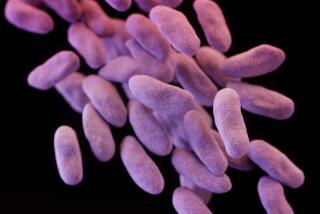Targeting Cancerous Tumors With Another Deadly Agent--Salmonella
- Share via
When three Yale scientists suggested in 1993 that a good way to kill cancer tumors might be to inject people with the deadly bacterium salmonella, the reaction of their peers was at best, well, mixed.
“Some people literally said, ‘You’re crazy,”’ recalled David Bermudes, now a senior scientists at Vion Pharmaceuticals Inc., a New Haven, Conn. biotechnology company specializing in cancer research.
But, Bermudes and two partners published results of their research in the scientific journal Cancer Research. The paper shows a genetically altered strain of salmonella--best known as a source of food poisoning from mishandled poultry--had significantly reduced growth of melanoma tumors and extended the lives of laboratory mice.
The results of their work have been so promising that tiny Vion is supporting nearly 20 scientists at Yale and in the company’s Science Park headquarters, hoping that salmonella therapy will catapult Vion into the top rank of oncologic research companies.
And the three researchers hope therapy will one day play as big a role in suppressing tumor growth as chemotherapy and radiation treatment.
“In 25 years in the business this is the most exciting thing I have seen in cancer research,” said John Spears, president and chief executive officer at Vion.
How the Yale researchers stumbled across such a radical idea is a story of scientific serendipity that brought three men of diverse science backgrounds together.
And an odd confluence of events led melanoma researcher John Pawelek to find a bizarre solution to a knotty problem in the same building at the Yale School of Medicine.
All the serendipity in the world however, can’t make a scientific breakthrough without cash, and Vion has been supporting the work since 1993. Still, Spears acknowledged the project was almost killed as “just too crazy.”
Eventually, Vion hired Bermudes and licensed the technology from Yale. Tiny Vion, with market capitalization of about $50 million, has sunk nearly $20 million into the project to date.
That’s a huge bet for a young biotech company such as Vion, a start-up company that went public in August 1995.
Like nearly all biotech start-ups, Vion expects to lose money for years, and in 1996 it reported just $100,000 in revenue and a net loss of $7.6 million.
“Biotech is not for the weak of heart,” Spears said.
The story begins in 1992 when Pawelek read a book by University of Massachusetts microbiologist Lynn Margulis. Margulis developed the theory, now widely embraced, that all multi-cell organisms arose from a sort of cooperative hybridization of ancient bacteria.
Pawelek wrote to Margulis that he was intrigued by a theory that the spread of cancer involved a similar hybridization between white blood cells and cancer cells.
Margulis wrote back and recommended that he talk to her former doctoral student, Bermudes, an expert on parasites who was familiar with hybridization in evolution.
It turned out that Bermudes was working on how parasites affect white blood cells--just three floors above Pawelek’s own labs.
Bermudes had little experience in cancer research, but he was intrigued by Pawelek’s thoughts about the connection between white blood cells and the spread of cancer.
Soon after talking to Pawelek, Bermudes said, he had a dream in which he was reading a paper about how parasites attack white blood cells. The next morning, he said, “Why not parasites attacking cancer cells?”
The two eventually focused on salmonella, a particularly insidious and virulent bacterium that causes food poisoning and septic shock, another potentially fatal bacterial infection.
Salmonella’s adroitness at worming its way into the cells of its victims made it a particularly attractive agent to attack deep into cancer tumors. Salmonella, it turned out, can even swim into tumors not fed by blood vessels. And during early tests on mice, salmonella itself seemed to inhibit tumor growth before infections killed the mice.
Neither Bermudes nor Pawelek, however, knew how to neutralize the sometimes lethal effects of salmonella. So Pawelek contacted K. Brooks Low, another Yale colleague who was an expert on salmonella’s close genetic cousin, the widely studied E. coli bacterium, which also has been implicated in some food poisoning cases.
It was Low who would strip salmonella of its harmful effects by engineering the strain so that it fed only on nutrients within the cancer tumor. At the same time, Pawelek and Bermudes engineered the salmonella so it also carried a known tumor-killing enzyme.
“It’s like training hounds to react to the scent of prey,” Pawelek said.
Despite receiving high levels of salmonella, the lab mice showed no signs of infection, the trio reported. And unlike other therapies that must be introduced directly into tumors, the salmonella can reach its target through the bloodstream.
And that characteristic is “the Holy Grail of cancer research,” Spears said.
For his part Pawelek believes the therapy may revolutionize the treatment of cancer. But he retains a hearty respect for diabolically complex disease.
“Salmonella is very clever,” he said. “But cancer is clever too.”






